July 27th, 2012 § Comments Off on Some things are worth the garlic breath § permalink
When I discovered that our CSA box this week contained a head of fresh garlic, it seemed criminal to just chop it up and toss it in a stir-fry. No, no, no, that just wouldn’t do. Not long ago I spent an entire Thursday afternoon at the farm pulling weeds from that never ending sea of garlic you see down below. Having helped to bring that head of garlic in to being, I didn’t want it going into some second rate dish, I wanted it to be the center piece of something wonderful. I wanted to make raw garlic carbonara.

It’s a delightful thing, and I am extremely tempted right now to just give up the recipe and be done with it. Maybe employ a little peer pressure: “Don’t wuss out, come on, everyone one else it trying it. What are you waiting for?! You should be cooking!” But I don’t think that I can in good conscience lure you, my oh-so trusting reader, into this glorious, eye-watering garlic extravaganza without full disclosure of the risks.
You see, raw garlic carbonara was one of the first recipes I learned to make from my very first vegetarian cookbook, The Passionate Vegetarian. Up until that point the vegetarian meals I had begun cooking for myself had seemed bland. I feel differently about vegetarian cooking now, but at the time I was plagued by an internal, nagging mantra of self-questioning: “Where’s the bacon? where’s the meat? where’s the excitement?!†Then I tried this pasta. The raw garlic made for a different kind of spiciness, one that was pungent and totally in my face, and unlike anything I had eaten. I am going to go out on a limb here and claim that my very first bite was a transcendent experience. That’s right, transcendent. It set a whole new bar for the level of flavor I was comfortable with adding to a dish.
And so for 8 months or so, maybe a year, I happily made this pasta almost every other week. Then I met Dave, and things started to get serious, and one night I decided that I would cook him my favorite meal. If he loved it, I thought, it could be our favorite meal together and wouldn’t that just be swell? In my girlish enthusiasm, I added one extra clove, and then another, and by the time I was done I think I must have added the entire head.
Can you see where this is going?

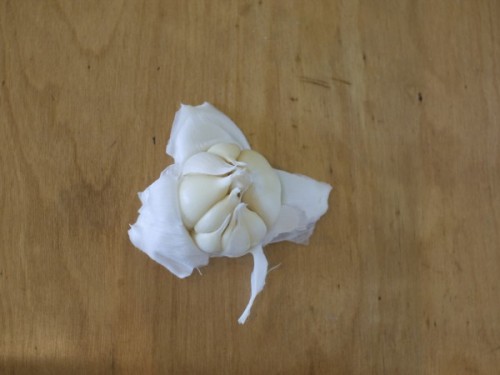
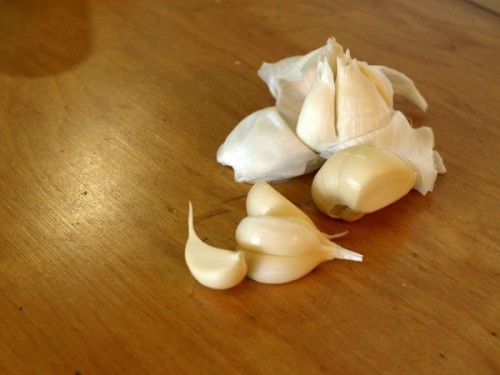
It was an extra spicy, extra special dish, and Dave and I devoured it enthusiastically. Little did I realize the curse I had wrought on our romantic evening. Halitosis… garlic breath!. Probably the worst I have ever, and hopefully will ever, experience. I know now that there’s not much to do but wait it out – wikipedia confirms it. Still, that didn’t stop us digging through my cupboards in search of some magical, date-night saving home remedy: Tooth brushing? it added a minty freshness, but did nothing for the garlic; Parsley? it tasted real nice, but still nothing; Suck on a stainless steel spoon? it didn’t work after the first 5 minutes, and it certainly didn’t work after a second 5 minutes.
Not that it mattered, in the end. Dave and I both really do love garlic. I wish I could say that was the last time that one of my meals went a bit overboard with the allyl methyl sulfide compounds, but I am not very good at learning that sort of lesson. Some things, I’ve decided, are just worth the garlic breath.
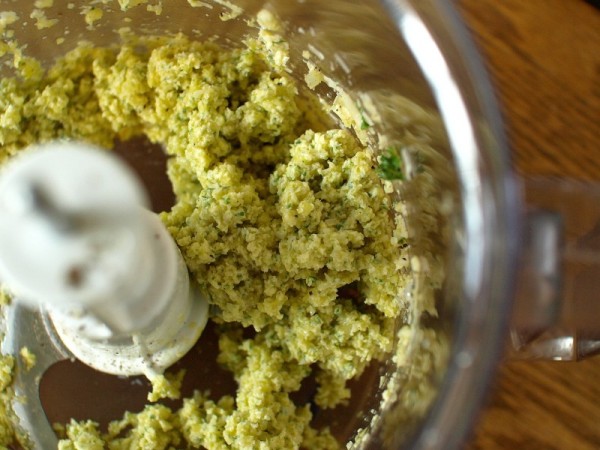

And yet, I recognize that it’s not for everyone. Or at least, that it’s probably not the best first choice for impressing someone you hope to kiss soon afterwards. So the other day I set about trying to make this recipe it a bit more accessible. I settled on adding only a couple of cloves of garlic raw, and then I sauteed the rest. The sauteed garlic adds a bit of sweetness and nuttiness, and really rounds out the flavor of the sauce. It still has the spiciness of the raw garlic, just toned way, way back.
Garlic Spaghetti Carbonara
Adapted from the Passionate Vegetarian
If you’re feeling like a solid, garlicky kick in the nose, I wholeheartedly encourage you to skip the sautee and try this recipe with only raw garlic. The strength of raw garlic can be a wee-bit unpredictable, but I think 6 or 7 cloves is usually a good number. Don’t be a hero.
In addition to the garlic, I should note that the egg is also intentionally raw to start. In a pasta alla carbonara like this one, the hot pasta takes a bit of the edge off the raw garlic, and cooks the egg just enough to bring the sauce together into a creamy, glorious mess.
350g / 12oz whole-wheat spaghetti or linguine
2 tsp olive oil
2-3 cups spinach or kale, washed and dried and torn into bite sized pieces (optional)
6 to 7 cloves garlic (or to taste), peeled and chopped into large pieces
1 large egg, raw
1/4 cup butter, softened
1/3 cup freshly grated parmesan or romano cheese
1 tbsp fresh basil
1 tbsp fresh parsley
dash of salt and freshly ground black pepper
Bring a large pot of salted water to a boil. Drop in the pasta and cook until al dente. Drain, reserving a bit of the extra pasta water in the process, and set aside.
If your are sauteing some of the garlic and/or adding greens: Heat a tsp of the olive oil in a large skillet over medium heat, about 3/4 of garlic, and saute until just soft but not yet brown, about 1-2 minutes. Remove the garlic pieces from the pan. Add your greens to the skillet and cook until they’ve just wilted, 1-2 minutes.
Combine garlic(s), eggs, butter, cheese, herbs, a dash of salt and a bit more pepper in a food processor. Pulse to combine until you achieve a thick paste.
Return the pot you used to cook the pasta to the stove and heat the remaining olive oil. Add the cooked pasta and the cooked greens (if using), stir over medium heat for about 2 minutes until the pasta is nice and hot. Remove from heat, and dollop the pasta with the garlic paste. Toss to combine, and if it seems a little dry, drizzle in some of the reserved pasta water. Top with a sprinkle of cheese, serve immediately.
Makes 3 – 4 servings
May 22nd, 2012 § § permalink
The last (and also, only a bit shamefully, the first) time I was inspired to post a recipe in this space came not too long after the final shift of last year’s season at UBC farm. For the intervening 6 months since that time I have been in a deep, creative hibernation -in other words, working tirelessly to survive the first year of my master’s degree – at least as far as food was involved.
But now it’s spring. The first year of my program is over(!) and even though it’s still really wet, it’s a warm sort of wet, and it’s pleasant and things are growing out there and I couldn’t be happier! And once again, I’ve been inspired by my experiences on the UBC farm to share a new recipe with you all.

One of my volunteering gigs at the farm is as a farm friend with a program called Landed Learning. Every other Wednesday morning, and many other days that I don’t attend, green thumbs like myself get together with much older and wiser volunteers to mentor groups of school kids on the wonders of growing things that they can eat. Each group of 4-5 kids gets their own garden plot, and together we’ve spent the last 8 months (with a few months off in the middle of winter) planning and planting and composting and harvesting and cramming more about growing food into their 8 – 12 year old brains than I thought possible. It’s truly a fabulous program.
Anyone who knows me well has heard me go on and on and ooooon about how much I enjoy and look forward to getting my hands filthy with these kids. But my favoritest (yes, favoritest) thing about the program is this: each week, one of the groups cooks or bakes something for all their classmates to share during lunchg using ingredients from the garden. This is a really important opportunity for some kids who might not otherwise get into the kitchen to try their hands at cooking. Maybe more importantly, making food to share with others in your community is a priceless experience for people of all ages.
There’s just one thing. . . You see, these kids have been coming out since the beginning of March, and as you might imagine, there’s not typically a lot of food growing in a Canadian garden in March, even in Vancouver. But the children’s garden has kale. Lots and lots and lots of kale. I know that other greens can technically overwinter here, but for the last couple months it’s just been a unconquerable sea of red russian kale.
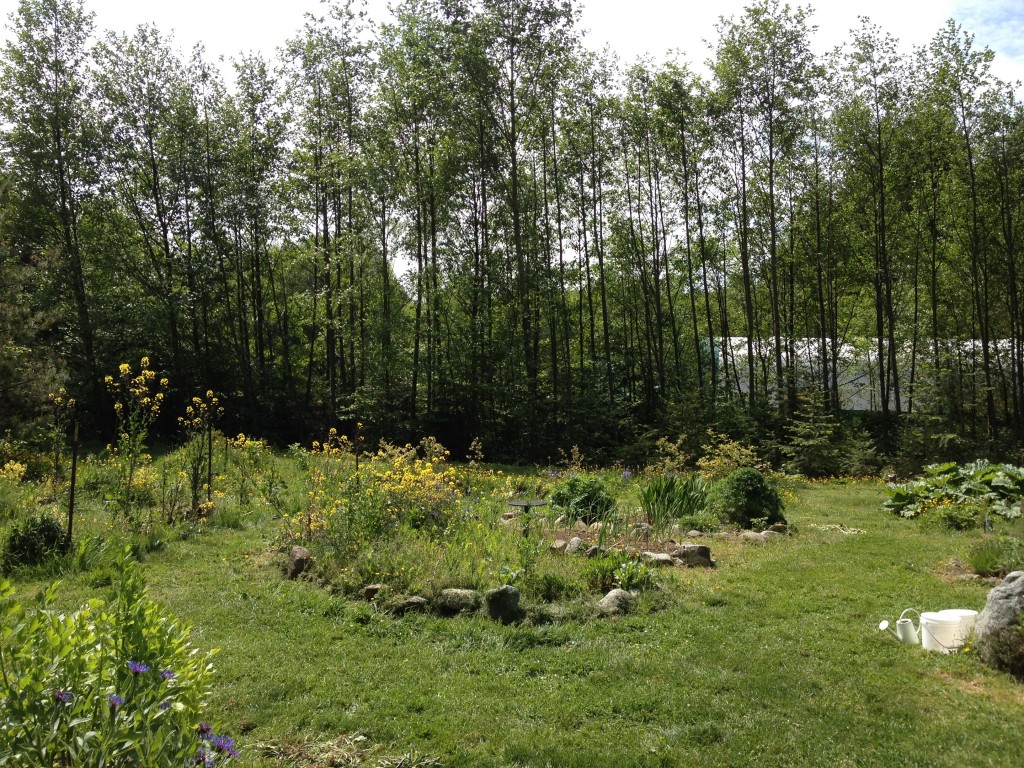
See all those yellow flowers in the above image from the farm? That’s kale. Well, the stuff near the ground off in the back might be dandelions, but I assure you that it’s mostly kale, gone to seed. And if you’re thinking to yourself that kale and pre-teens don’t go together, let me stop you right there. For the most part, those kids will try anything, and many of them truly love the kale that they grow in the garden. Some days it’s all I can do to keep them from eating the kale that they find in other group’s plots right down to the soil. “No, you can’t just take a couple ‘bug-sized’ nibbles. Leave that leaf alone!”

Even the most kale adoring omnivores will get sick of it when it’s the only thing that’s growing. The kids have been real troopers though, and with the help of the program organizers they’ve been making all number of creative kale foodstuffs each week, from a simple kale salad to kale sushi and open-faced kale blossom sandwiches. Thankfully, even though the planting season usually begins for most of Canada this may long weekend (or later . . . sorry about that frost Calgary :/), we’ve been planting in Vancouver for weeks now. The garden plots are already starting to fill up with lettuce and spinach and radishes that are just asking to be munched on. Along with the fact that the kale seems to have finally reached the end of its days, this means that the never-ending era of kale, as one child dubbed it, is almost certainly over.
That said, I am not even close to sick of kale. Far from it. And when I found myself with a large pot of polenta leftover from a cornbread experiment this afternoon, it was those inventive, tasty green dishes made by the kids that leapt to mind. So I reached for the kale in the fridge and whipped myself up a straightforward, light lunch of garlicky kale and goat cheese polenta. The greens give the polenta a refreshing edge, and I love the way that the cheese, stirred in a the end, only sort-of melts and creates a smooth and silky counterpoint to the polenta grains.
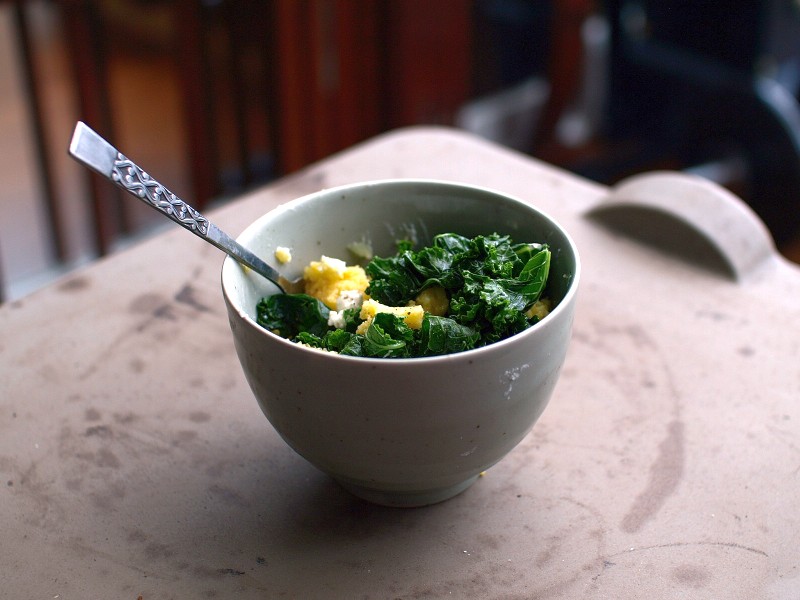
My take on the greens was loosely inspired by Heidi Swanson’s Garlicky Green’s Recipe. I also just love how that name sounds. This polenta recipe is more of a method than a science, and I can imagine substituting any number of greens (spinach, chard, collard) or cheeses (parmesan would be perfect) in this dish. Or, if you want to give it some weight and make it into more of a dinner, you could try beefing up the fried greens with some mushrooms and onions or whatever else you like. It’s a flexible combination, so I encourage you to be adventurous.
Garlicky Green Polenta
If you’re a frequent polenta eater, feel free to make this with leftovers from the day before. I find leftover polenta to be a bit thick and unwieldy – you can bring it back to life by reheating it on the stove and adding a bit of butter to smooth it out.
1 cup cornmeal or coarse polenta grains
3.5 cups water
2 tbsp butter (optional)
salt & pepper to taste
1 big bunch of kale (or spinach, chard or collards)
2 tablespoons extra-virgin olive oil
sea salt
4-5 cloves of garlic, minced.
2-4 tbsp goat cheese, crumbled
Bring the water to boil in a saucepan. In a thin stream, whisk in the cornmeal. Adding it too quickly usually results in lumps. Cook over medium-low heat, stirring occasionally, until thick. Generally this takes about 10 minutes, but I find that the cooking time can vary anywhere from 4 – 15 minutes depending on the coarseness of your grains.
Once thick, remove from heat and stir in the butter until smooth. (If like me, you prefer a chunkier polenta, feel free to leave out the butter). Add a bit of salt and pepper to taste.
While the polenta is cooking, wash the kale leaves thoroughly in a bowl of clean water and then rinse in a colander. De-stem the kale and tear or cut the big leaves into bite-sized pieces.
Heat the olive oil in a large skillet or wok. Add the greens, and then a pinch of salt. They will sputter when they hit the pan. Stir continuously until the leaves turn bright green and wilt – usually about 4 minutes, depending on the heat and the type of kale. When the kale is just about wilted, stir in the garlic. Saute briefly, and then remove the pan from the heat.
Stir the cooked kale and half of the crumbled goat cheese into the polenta. Serve into individual bowls and top with the remaining goat cheese.
Serves 4 as a side, or 2 as a light lunch.









